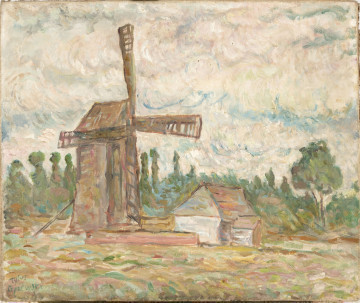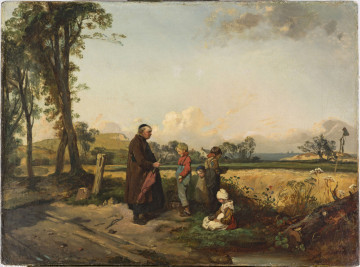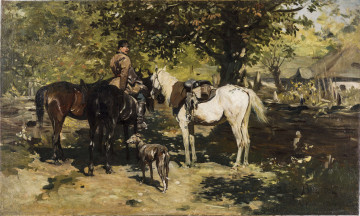
Landscape with a windmill
1936
National Museum in Lublin
Part of the collection: Polish landscape painting (19th–1st half of the 20th c.)
In the paintings of Ferdynand Ruszczyc, an outstanding artist of Polish Modernism, the manor house in Bogdanow appears many times and in various scenes. The old wooden house with whitewashed shutters, immersed in the surrounding nature, was exceptional in the painter's life. Situated in Lithuania, not far from Vilnius, Bogdanow was the family nest of the Ruszczyc family and Ferdynand's beloved house where he was born in 1870, lived most of his life and died in 1936.
The artist devoted his work almost exclusively to the native landscape. During several years of painting work, finally finished in 1908, he created canonical works of this genre for Polish art. His insightful observation of the world found a moving painterly expression in the form of created fragments of nature, carefully framed with the use of specific – raised or lowered – perspective (Młyn nocą [The Mill at Night], Z brzegów Wilejki [On the Banks of Wilejka]). This way of depiction was the result of the artists' interest in Japanese art at that time. Realistic views, however, hide encrypted, expanded, symbolic content. In the typical situation of Polish art, which was expected to promote national values, already around the middle of the 19th century the so-called symbolic landscape appeared, which developed for good in the art of Young Poland (among others A. Chmielowski, W. Pruszkowski, W. Weiss, J. Pankiewicz, S. Podkowiński, and J. Stanisławski). In Ruszczyc's painting, an example of such a landscape is his flagship painting entitled Ziemia [Land] from 1898. The representation of the Bogdanow Manor can also be interpreted in the broader context of the painter's biography and the fate of the Borderlands. The solid house symbolises a safe family haven while being set among the familiar nature against the background of a cloudy sky. A house in the borderlands was also a refuge and a guardian of national values. It can be seen a metaphor for a homeland threatened by various historical accidents in the broader sense. The billowing clouds in Ruszczyc's paintings, a foreboding of dangers, turned out to be a prophetic prediction of the events to come. During the Second World War, the Soviet army destroyed the manor buildings together with the park. The only remaining trace of the splendid old culture is the cemetery, where the grave of the great artist Ferdynand Ruszczyc, a man devoted to the Vilnius region, can be found.
Bożena Kasperowicz
Author / creator
Dimensions
cały obiekt: height: 50 cm, width: 45 cm
Object type
painting
Technique
oil technique
Material
canvas, oil-based paint
Creation time / dating
Creation / finding place
Owner
The National Museum in Lublin
Identification number
Location / status

1936
National Museum in Lublin

1856
National Museum in Lublin

1883
National Museum in Lublin
DISCOVER this TOPIC
Museum of King Jan III's Palace at Wilanów
DISCOVER this PATH
Educational path